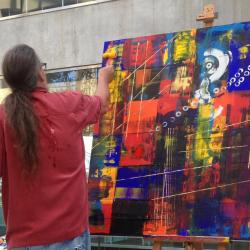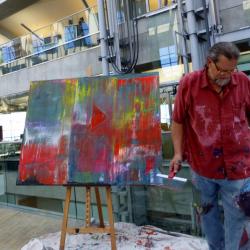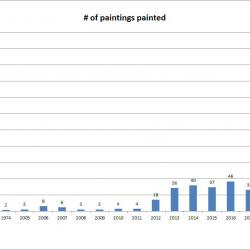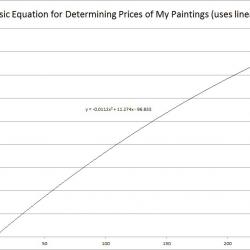-
Please note that clicking on any image in the gallery will enlarge it including graphs at the bottom of this page.
The Gallery is divided into major themes. Currently there are 24:
-
24x24 inches (2013-2017)
The first paintings in this series were painted for a show at Cafe Niche. I wanted a uniformed look for this resturant setting. I continue to use this size because I like the unique and stylish look of square paintings and the personal feel of this "small" size.
-
Climate Change and Air Quality (2011-2020)
The paintings in this series are painted as visual representation of Climate Change and Air Quality issues facing Utah and the world. The triptych Climate Change was featured in the 2015 Fall Isuue of UU World. Breathe Deep The Gathering Gloom Tetraptych was painted "plein air" at an outdoor air quality rally. The story goes that the metal objects in this painting represent everything I had coughed up the previous winter.
-
The Desert and Mountains of Utah (2005-2021)
The abstracts and landscapes in the series are of the deserts and mountains of Utah. The first time I visted Utah was in the summer of 1975 on my way to Arizonia for college. I have lived in Salt Lake City, Utah since the August of 1997.
-
Centennial Valley, Montana (2012/2013)
The abstracts and landscapes in this series are of Centennial Valley, Montana. A beautiful remote valley surrounded by mountains, located west of Yellowstone National Park, that is a patchwork of grasslands and wetlands.
-
Seascapes (2006-2019)
The paintings in this series depict the seas and their surrounding shores.
-
Beyond the Breakers, Poemscapes (2013-2016)
The paintings in this series represent phrases from my poem, "Beyond the Breakers".
from beyond the breakers where no giants swim
and the sun shines often upon an ancient sea…at night the waves glow below the moon,
an old bone white as fire's ash when a forest stands no more
suddenly a lightning flash seems so alone, for the moment it exists
reflected in a tidal pool
upon the shore soon washed to sea...below the cliffs soon washed to sea…
all the lands soon washed to sea…an ancient sea...beyond the breakers where no giants swim... -- wbr --
-
Womanscapes (2014,2018)
It seems that natural landscapes are often compared to the woman form---than what better way to paint semi-abstract landscapes than to use a female model. The technique developed by local abstract painter Bill Reed is a simple one. Trace a model directly pressed against a vertical canvas, having her pose in different positions and/or heights. Sometimes the model is facing right, sometimes left. Sometimes the model stands behing the canvas and the resulting silhouette is used. Sometimes the front profile is used, sometimes the back profile. After the tracing is done, the canvas is turned horizontal and the resulting womanscape is painted. Often the model chooses the color scheme. To describe his pieces Reed has coined the term womanscape.
-
Vertical Color of Sound (2013-2020)
Brian Eno: his music and the vertical color of sound/Eric Tamm is an interesting read...the phrase "vertical color of sound" has intrigued me...and has led to my attempts seen here of the visual representation of timbre (primarily as texture and attack as well as color and form).
The paintings in this series are acrylic ink poured not painted. The inks ran across the canvases rather than flowed slowly (also see fluid art theme below).
-
Botanicals (2006-2020)
This theme is a catch-all for paintings of plants and plant communities. The paintings are usually impressionistic or abstract.
-
People (2007-2019)
These are paintings of people including self portraits. I rarely attempt such paintings.
-
Buildings and Cityscapes (1970-2020)
This theme is a catch-all for paintings of buildings and cityscapes. I enjoy painting cityscapes representing different times of the day and night.
-
Science (2013-2019)
This theme has to do with all sciences including astrophysics and mathematics.
-
Textural Mixed Media (2013-2019)
The paintings in this series are mixed media in that textural items have been applied directly to canvas, added to the paint, or stuck directing into the paint while drying.
-
Dripped Acrylics and Mixed Media (2014-2020)
The paintings in this series were either entirely dripped or contained dripped elements. In 2018 I started using metallic paints as well, either as background or as dripped elements.
-
Performance Pieces (2013-2016)
The paintings in this series are painted as performances pieces. During the demonstration, the audience is asked to suggest color, texture, form, and changes in composition.
-
Minimalist (2016-2020)
The paintings in this series are difficult for me to paint but extremely rewarding, providing a mental exercise in restraint.
-
Curvilinear Abstraction (2016-2020)
These paintings are often rhythmic, childlike, yet complex. Sometimes representing the music they were painted too.
-
Fluid Art, Flow Acrylic including Mixed Media (2017-2020)
These paintings use fluid acrylics and/or acrylics mixed with a flow medium. Some of the paintings in this series have other ingredients added to the paint to produce unique effects. Some of these paintings were painted by the "dirty cup" method; some by the "swipe method". I have added metal on top of a few to provide a layered effect. In my mind, this is sort of like when muscians play rock music on top of a soundscape.
Water based paint with real metal particles that allows oxidizing finishes to be applied.
-
Encaustics (2013)
A fellow artist, Mary Tull, showed me how to paint with hot wax. So far I have only the one painting but may try this amazing art form again in the near future. I especially like how encaustic abstracts can look so similar to fluid acrylics.
-
Miscellaneous (2006-2020)
These are unique pieces that are not easily categorized. Many deal with raw emotion. Indeed if I labeled this theme Emotionscapes instead of Miscellaneous I would have to put all my paintings in it.
-
Large Paintings (2010-2020)
I enjoy painting large paintings (those greater that 1900 square inches). It is my opinion that abstracts are easier to paint when you paint larger canvases or across multiple canvases.
Colors and shapes found in common objects or places are always influencing me.
_________________



